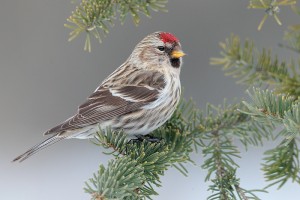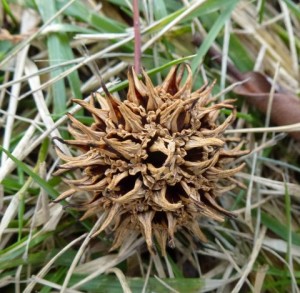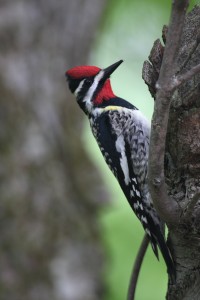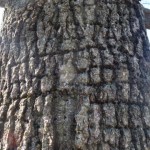By Edie Parnum
On a damp, cloudy day in December I took a break from my household chores to get some fresh air on my back deck. As usual I looked around for bird activity. Recently I’d been seeing birds eating the ripe seeds in the Sweet Gum tree (Liquidambar styraciflua), so I wasn’t surprised to see a feeding flock there. The light was dim, so I rushed back inside to retrieve my binoculars. I was pleased to spot my target species, a Pine Siskin, among the expected goldfinches. Then, I noticed an odd-looking bird. It was small and streaky like a siskin, but it had black around the base of the bill. Wow! It was a female Common Redpoll.

Photo of a Common Redpoll courtesy of Jacob Spendelow
Normally we don’t see redpolls in the Delaware Valley. They are circumpolar denizens of the arctic tundra and boreal forest. In northern Canada and Alaska, they feed on alders, birches, willows, and spruces. However, because the seed crop was poor this year, these birds are roaming southward in search of food. Birders have also spotted other northern species like Pine Siskins, Red Crossbills, White-winged Crossbills, and Evening Grosbeaks that have wandered south to find food. Ornithologists call this phenomenon an irruption. Some of these northern birds, including redpolls, have been showing up at area feeders.
In 1996, another irruption year, I hosted four Common Redpolls at my thistle feeder. Redpolls are small finches slightly bigger than goldfinches. They have brown streaks on their flanks and back, white wing bars, a small red cap (called a poll), and the aforementioned black around the bill. The male has a rosy-pink wash across its breast. With their strong claws they can easily hold onto small twigs and sometimes hang upside down acrobatically to reach the dangling sweet gum balls. With their tiny, pointy beaks they can easily reach into the cavities of the Sweet Gum balls to extract the small seeds.
My Sweet Gum nourishes many wild creatures, not just redpolls, goldfinches, and siskins. I regularly see Dark-eyed Juncos, House Finches, Red-winged Blackbirds
and sometimes Golden-crowned Kinglets and Purple Finches devouring the seeds. I’ve heard reports of White-winged and Red Crossbills eating Sweet Gum seeds, too. When the seeds are ripe I enjoy standing under the tree as the seeds rain down copiously around me. Sparrows and Mourning Doves relish the wind-dispersed seeds they find on the ground, the driveway, and the roof.
Yellow-bellied Sapsuckers, cold weather visitors from the north, hammer holes in the bark and drink the sap. Thirty-three species of native caterpillars including the Luna Moth, a declining species, eat the foliage.
Plant a Sweet Gum in your yard. It’s a handsome tree in all seasons. In the fall, it is spectacularly adorned with shiny red, orange, and yellow leaves. True, the prickly, woody balls fall to the ground well after leaves have been raked in the fall and, thus, require an untimely extra clean-up. Personally, I like these odd, somewhat monstrous-looking fruits. As I child I used them for making Christmas ornaments. To my way of thinking, a Sweet Gum tree is well worth planting for the chance to host caterpillars and birds like redpolls and sapsuckers.





How big are the Sweet Gum seeds? Like a thistle seed?
Sandra,
Yes, they are about the size of nyjer thistle seeds. Take a look under any Sweet Gum tree, and you’ll see lots of them. The peak season for the seeds was in December.
Edie
Sweet gum trees are are known to provide a roost for migrating monarch butterflies in Cape May.
Hi Dianna,
I didn’t know Monarchs use Sweet Gums for roosting. I well remember when we saw hundreds of Monarchs roosting in Eastern Red Cedars in Cape May. It was one of my peak nature experiences.
Edie